Enabling Concurrent OBIEE RPD Development - for free

One of the most common and long standing problems with developing in OBIEE is the problem of multiple developers working on the RPD at the same time. This blog explains the problem and explores the solution that we’ve developed and have been successfully using at clients over the last couple of years. We’re pleased to announce the immediate availability of the supporting tools, as part of the Rittman Mead Open Source Project.
Before we get into the detail, I'll first explain a bit about the background to the requirement and the options that ship with OBIEE.
Why Concurrent Development
The benefits of concurrent development are obvious: scalability and flexibility of development. It enables you to scale your development team to meet the delivery demands of the business. The challenge is to manage all of the concurrent work and enable releases in a flexible manner - which is where source control comes in.
We couldn't possibly attempt to manage concurrent development on something as complex as the RPD without good version control in place. Source control (A.K.A. version control/revision control) systems like Git and Apache Subversion (SVN) are designed to track and retain all of the changes made to a code base so that you can easily backtrack to points in time where the code was behaving as expected. It tracks what people changed, who changed it, when they changed it and even why they made that change (via commit messages). They also possess merge algorithms that can automatically combine changes made to text files, as long as there are no direct conflicts on the same lines. Then there's added benefits with code branching and tagging for releases. All of this leads to quicker and more reliable development cycles, no matter what the project, so good in fact that I rely on it even when working as one developer. To (mis)quote StackOverflow, "A civilised tool for a civilised age".
All of these techniques are about reducing the risk during the development process, and saving time. Time spent developing, time spent fixing bugs, spent communicating, testing, migrating, deploying and just about every IT activity under the sun. Time that could be better spent elsewhere.
Out of the Box
Oracle provide two ways to tackle this problem in the software:
- Online Check in/out
- Multi-User Development (MUD)
However I believe that neither of these are sufficient for high standards of reliable development and releases - the reasons for which I explore below (and have been described previously). Additionally it is not possible to natively and fully integrate with version control for the RPD, which again presents a significant problem for reliable development cycles.
Firstly the online check-in and check-out system does, by design, force all development to be conducted online. This in itself is not an issue for a single developer, and is in fact a practice that we advocate for ‘sandbox’ development in isolation. However, as soon as there is more than one developer on the same server it reduces development flexibility. Two developers cannot develop their solutions in isolation and can be made to wait for assets they want to modify to be unlocked by other developers. This may be workable for a small amount of developers but does not scale well. Furthermore, the risk of losing work is much higher when working online; we've all seen the infamous "Transaction Update Failed" message when saving online. This is usually because of an inconsistency in the RPD but can be caused by less obvious reasons and usually leads to repeating some redundant work. Lastly, very large RPDs like those from BI Apps or very mature enterprise deployments pose a problem when working online. They cause the Admin Tool to work very slowly because of the calls it has to make to the server, which can be frustrating for developers. To be clear, I am certainly not advocating developing without testing your code, but given the speed of uploading an RPD to the server and the fact that it can be automated, in my experience it is far more efficient to develop offline and upload frequently for testing.
The MUD system is much better and is quite close in methodology to what we recommend in this guide. The premise works on having a production quality master RPD and then having many other individual developers with their own RPDs. The check-in and check-out system will automatically handle three-way merges to and from the master RPD when development changes are made. This is good in theory but has been maligned for years when used in practice. The version control system in MUDE is not as robust as Git or SVN for example and the conflict resolution relies on developers managing their own issues, without the ability for a source master to intervene. Ultimately there is little flexibility in this method, which makes it difficult to use in the real world.
Source Controlling the RPD
Source control is another problem as the RPD is a binary file which cannot be merged or analysed by text-based comparison tools like SVN or Git. A potential solution at one point seemed to be MDS XML, a structured, textual representation of the RPD. However, this also seemed to have some drawbacks when put into practice. Whilst some use MDS XML with great success and there are tools on the market that rely on this system, here at Rittman Mead we’ve found that there are significant risks and issues with it. We’ve come up with what we believe is a robust, scalable, and flexible approach, based around the binary RPD.
The Rittman Mead Solution to Concurrent OBIEE RPD Development
Successful development lifecycles comes down to implementation of the correct process and ensuring it is as quick and reliable as possible. Tools, like the ones described in this blog, can be used to help in both of those areas but are not a substitute for detailed knowledge of the processes and the product. A key feature of this approach is the Source Master who owns and is responsible for the overall development process. They will have a detailed understanding of the method and tools, as well as the specifics of the current and future work being done on the RPD. Things will go wrong, it is as inevitable as death and taxes - the key is to minimise the impact and frequency of these events.
The solution is based on the Gitflow method, which is one of the most established development models. The model is based on a few major concepts:
- Features - Specific items of development, these are begun from the development branch and then merged back into development when complete.
- Develop/Master Branches - Two branches of code, one representing the development stream, the other the production code.
- Releases - A branch taken from development that is then eventually merged into production. This is the mechanism for getting the development stream into production.
I highly recommend reading that blog and this cheatsheet as they explains the method excellently and what we've done here is support that model using binary RPDs and the 3-way merge facility in OBIEE. Also of relevance is this Rittman Mead blog which describes some of the techniques we're explaining here. We've open sourced some command line tools (written in Python) to ease and automate the process. You can download the code from the GitHub repository and need only an install of Python 2.7 and the OBIEE client to get started. The tooling works with both git and Subversion (SVN). We recommend the use of git, but realise that SVN is often embedded at organisations and so support that too.
Scenario
This section shows a simple example of how you might use this methodology for multiple developers to work on the RPD in a reliable way. Many of the screenshots below show SourceTree, a GUI for Git which I'm a fan for both its UI and GitFlow support.
We have two developers in our team, Basil and Manuel, who both want to work on the RPD and add in their own changes. They already have an RPD they've made and are using with OBIEE, named base.rpd. First they initialise a Git repository, committing a copy of their RPD (base.rpd).
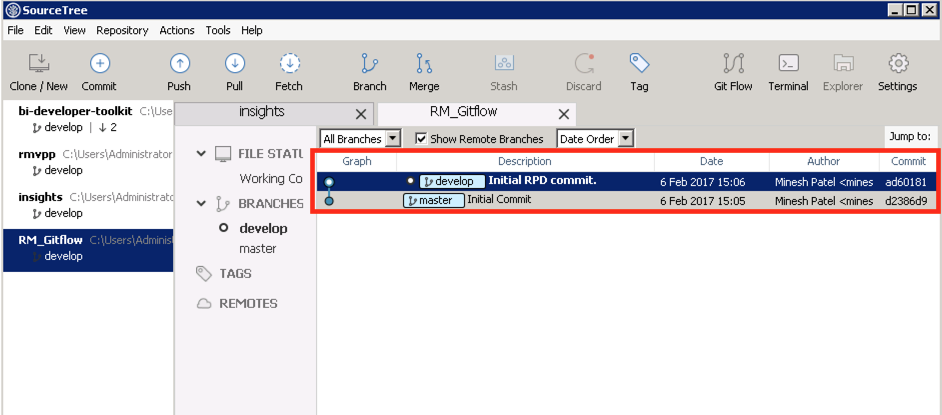
The production branch is called master and the development branch develop, following the standard naming convention for GitFlow.
Before we get started, let's a take a look at the RPD we're working with:
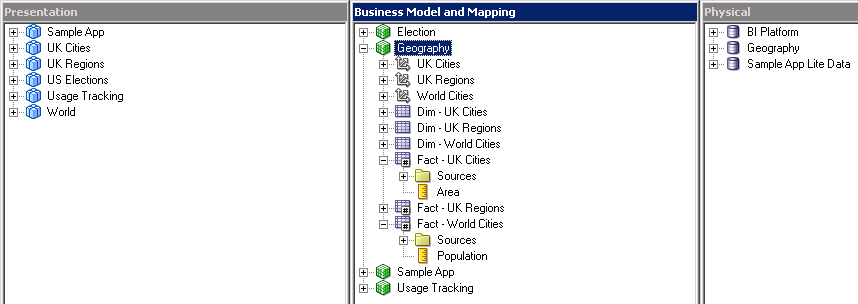
Simple Concurrent Development
Now Basil and Manuel both independently start features F01 and F02 respectively:
python obi-merge-git.py startFeature F01
Each developer is going to add a measure column for Gross Domestic Product (GDP) to the logical fact table, but in different currencies. Basil adds "GDP (GBP)" as a logical column and commits it to his development branch, F01. Manuel does the same on his, adding "GDP (USD)" as a logical column and committing it to F02.
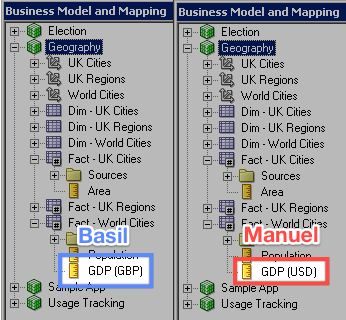
Now Basil finishes his feature, which merges his work back into the develop branch.
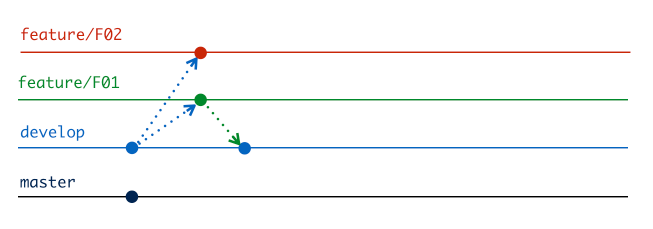
This doesn't require any work, as it's the first change to development to occur.
python obi-merge-git.py finishFeature F01
Checking out develop...
Already on 'develop'
Merging feature/F01 into develop...
Successfully merged feature/F01 to the develop branch.
When Manuel does the same, there is some extra work to do. To explain what's happening we need to look at the 3 merge candidates in play, using the terminology of OBIEE’s 3-way merge functionality:
- Original: This is the state of the development repository from when the feature was created.
- Modified: This is your repository at the time of finishing the feature.
- Current: This is the state of the development repository at the time of finishing the feature.
When Basil completed F01, the original and current RPDs were the same, so it could just be overridden with the new RPD. However now, the Original and Current RPDs are different, so we need to resolve the changes. Our RPDs are binary files and so we need to use the 3-way merge from the Admin Tool. The python script wrapped around this process uses Git’s metadata to determine the appropriate merge candidates for invoking the OBIEE 3-way merge.

Since our changes do not conflict so this can happen automatically without user intervention. This is one of the critical differences from doing the same process in MDS XML, which would have thrown a git merge conflict (two changes to the same Logical Table, and thus same MDS XML file) requiring user intervention.
python obi-merge-git.py finishFeature F02
Checking out develop...
Already on 'develop'
Merging feature/F02 into develop...
warning: Cannot merge binary files: base.rpd (HEAD vs. feature/F02)
Creating patch...
Patch created successfully.
Patching RPD...
RPD patched successfully.
RPD Merge complete.
Successfully merged feature/F02 to the develop branch.
In the background the script uses the comparerpd and patchrpd OBIEE commands.
Release
Now our development branch has both features in, which we can see using the Admin Tool:
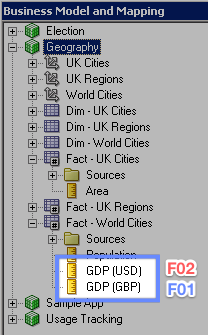
To get this into production we can start a release process:
python obi-merge-git.py startRelease v1.00
This creates a new branch from develop that we can use to apply bug fixes if we need to. Any changes made to the release now will be applied back into development when the release is complete as well as being merged into the production branch. The developers realise they have forgotten to put the new columns in the presentation layer, so they do it now in the release branch as a bugfix. In GitFlow, bugfixes are last minute changes that need to be made for a release but do not interfere with the next development cycle, which may have already begun (in the develop branch) by the time the bug was spotted. The changes are merged back to develop as well as master so the fix isn't lost in the next cycle.
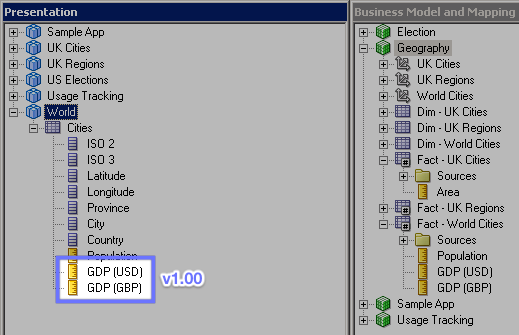
This is committed to the repo and then the release is finished:
python obi-merge-git.py finishRelease v1.00
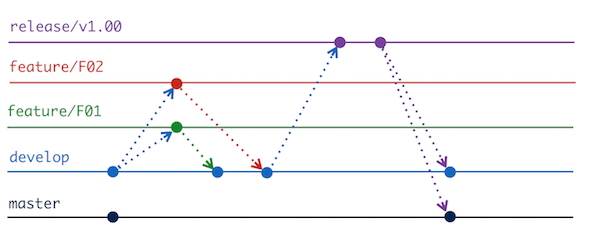
After the release we can see that the master and develop branches are at the same commit point, with a tag of the release name added in too. Additionally we can switch to the develop and master branches and see all of the changes including the columns in the presentation layer. The full commit history of course remains if we want to roll back to other RPDs.

Conflicted Development
Basil and Manuel start their new features, F03 and F04 respectively. This time they’re working on the same existing column - something that a “Source Master” should have helped avoid, but missed this time. Basil edits the column formula of the "Area" column and renames it to "Area (sqm)"" and Manuel does the same, naming his column "Area (sqFt)".
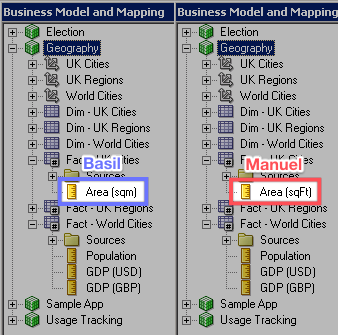
They both commit the changes to their own feature branches and Manuel merges his back to development with no problem.
python obi-merge-git.py finishFeature F04
However when Basil tries to finish his feature the obvious conflict occurs, as the automatic merge cannot resolve without some human intervention since it is the same object in the RPD affected by both changes. At this point, the script will open up the current RPD in the Admin Tool and tell Basil to merge his changes manually in the tool, going through the usual conflict resolution process. The script provides 3 RPDs to make the RPD choosing step unambiguous:
original.rpdmodified.rpdcurrent.rpd(Opened)
python obi-merge-git.py finishFeature F03
Checking out develop...
Already on 'develop'
Merging feature/F03 into develop...
warning: Cannot merge binary files: base.rpd (HEAD vs. feature/F03)
Creating patch...
Patch created successfully.
Patching RPD...
Failed to patch RPD. See C:\Users\Administrator\Documents\obi-concurrent-develop\patch_rpd.log for details.
Conflicts detected. Can resolve manually using the Admin Tool.
Original RPD: C:\\Users\\Administrator\\Documents\\rpd-test\a.rpd (original.rpd)
Current RPD: C:\\Users\\Administrator\\Documents\\rpd-test\c.rpd (Opened)
Modified RPD: C:\\Users\\Administrator\\Documents\\rpd-test\b.rpd (modified.rpd)
Perform a full repository merge using the Admin Tool and keep the output name as the default or C:\\Users\\Administrator\\Documents\\rpd-test\base.rpd
Will open RPD using the Admin Tool.
Press Enter key to continue.
You must close the AdminTool after completing the merge manually in order for this script to continue.
When Basil hits a key, the Admin Tool opens up, and from here he needs to manually initiate the merge and specify the merge candidates. This is made easy by the script which automatically names them appropriately:
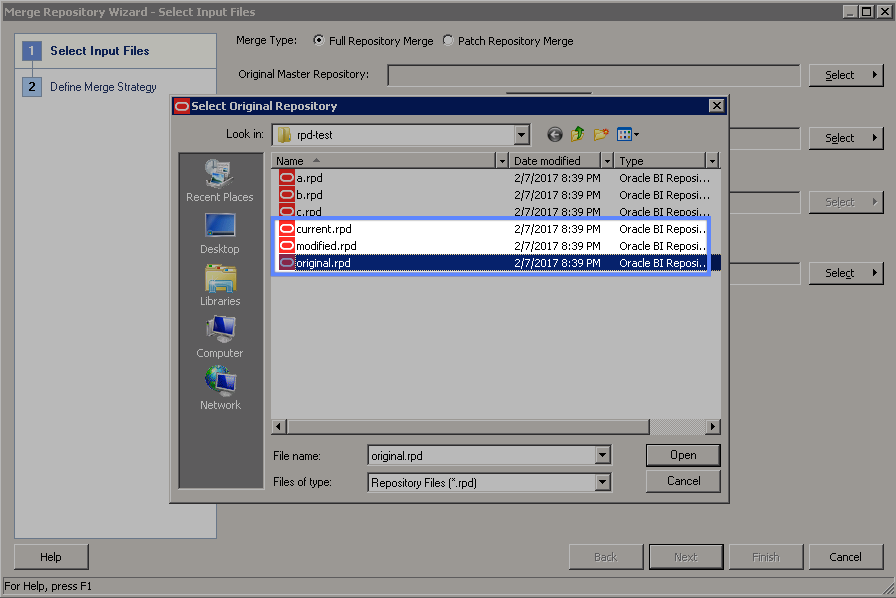
Note that the a, b and c RPDs are part of the merge logic with Git and can be ignored here.
Basil assigns the original and modified RPDs to the correct parts of the wizard and then resolves the conflict (choosing his change) in the next step of the wizard.
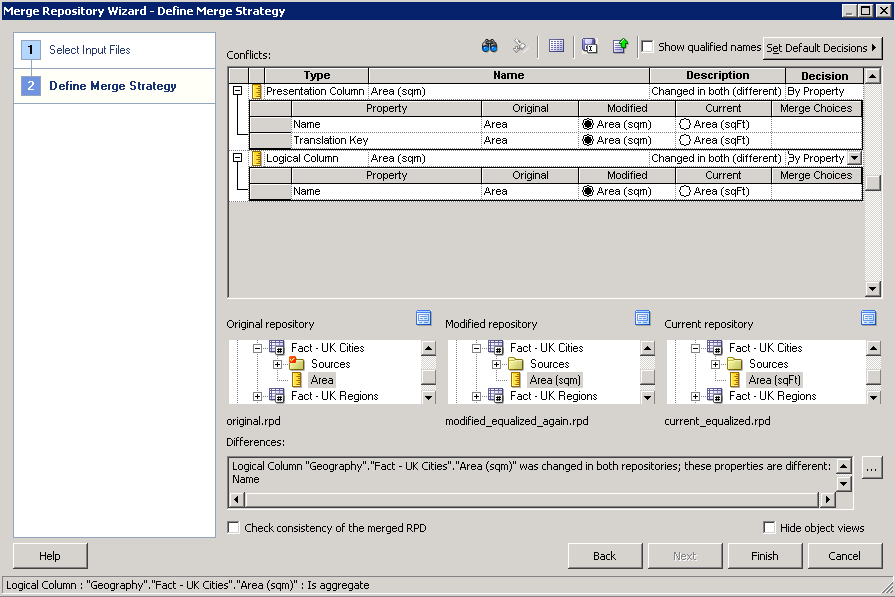
Upon closing the Admin Tool, the Git merge to the develop branch is automatically completed.
Now when they look in the development RPD they can see the column named as "Area (sqm)", having accepted Basil's change. Of course this is a trivial example, but because the method relies on using the Admin Tool, it will be just as reliable as a manual 3-way merge you would perform in OBIEE.
In my experience, most of the problems with 3-way merging is that developers get confused as to which candidates to choose or they lose track of a true original point from when both developers started working. Using this method eliminates both of the those problems, with the added benefit of tight integration into source control. Even with an easier interface to the 3-way merge process, developers and/or the Source Master should be aware of some of the ‘features’ of OBIEE’s 3-way merge. For example, if a change has occurred on the physical layer which does not have any representations at all in the business or presentation layers, it may be lost during a 3-way merge. Another is that the merge rules are not guaranteed to stay the same between OBIEE versions, which means that we cannot be certain our development lifecycle is stable after patching or upgrading OBIEE.
So given this, and as a general core tenet of good software development practice, you should be automatically testing your RPDs after the merge and before release.
Testing the RPD
There are still issues with OBIEE RPD merging that aren't rectified by the 3-way merge and so must be handled manually if and when they occur. One such example is that if a change has occurred on the physical layer which does not have any representations at all in the business or presentation layers, it may be lost during a 3-way merge. Another problem is that the merge rules are not guaranteed to stay the same between OBIEE versions, which means that we cannot be certain our development lifecycle is stable after patching or upgrading OBIEE. Another thing I don't really like is the inherent bias the merge process has toward the modified RPD, instead of treating the modified and current RPDs equally. The merge candidates in the tool have been selected in such a way as to mitigate this problem but I am wary it may have unforeseen consequences for some as yet untested scenarios. There are may be other inconsistencies, but it is difficult to pin down all of the scenarios precisely and that's one of the main stumbling blocks when managing a file as complex as the RPD. Even if we didn't receive any conflicts, it is vital that RPDs are checked and tested (preferably automatically) before release.
The first step to testing is to create a representative test suite, which will encompass as much of the functionality of your system in as few reports as possible. The reason for this is that it is often impractical and sometimes invalid to check the entire catalogue at once. Furthermore, the faster the testing phase occurs, the quicker the overall release process will be. The purpose of a test suite is so that we can take a baseline of the data of each report from which we can validate consistency after making changes. This means your test suite should contain reports that are expected not to change after making changes to RPD. Furthermore you need to be careful that the underlying data of the report does not change between the baseline capture and the regression validation phases, otherwise you will invalidate your test.
In terms of tooling, Oracle provide BVT which can be used outside of upgrades to perform automated regression tests. This is good as it provides both data checks as well as visual validation. Furthermore, it can be run on a specific Web/Presentation Catalog folder directly, as opposed to the whole system.
As well as Oracle’s BVT, we also have an in-house Regression Testing tool that was written prior to BVT’s availability, and is still used to satisfy specific test scenarios. Built in Python, it is part of a larger toolset that we use with clients for automating the full development lifecycle for OBIEE, including migrating RPDs and catalogue artefacts between environments.
This brings us onto the last piece in the DevOps puzzle is continuous integration (CI). This is the concept of automatically testing and deploying code to a higher environment as soon as the work is complete. This is something not explicitly covered by the tools in this blog, however would work nicely used with the testing and migration scripts described above. This could all be made seamless by invoking the processes via script calls or better using Git hooks.
Summary
The success of an OBIEE concurrent development approach comes down to two things: the tooling, and the rigorous implementation of the process - and it is the latter that is key. In this article I’ve demonstrated the tooling that we’ve developed, along with the process required for a successful development method. Here at Rittman Mead we have detailed understanding and experience in the process and framework necessary to implement it at any client, adapting and advising to ensure the integration into existing in-house development and release requirements. The real world is messy and developers don't all work in the same way. A single tool in isolation is not going to succeed in making OBIEE - designed from the outset as a single-developer tool - scale to multiple developers. Instead of insisting that you change to accommodate our tool, we instead bring our tool and process and adapt to suit you.
You can find the code used in this blog up on GitHub and if you would like to discuss how Rittman Mead can help implement concurrent OBIEE RPD development successfully at your organisation, please get in touch.
